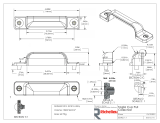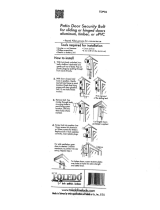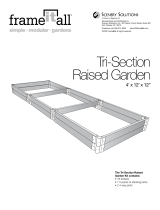
Outer - Cutter, Perf & Drill Guide
Perf
Fold
Fold
HOWDENS/FD30/IFC-CERT/v1/Nov2020
International Fire Consultants Limited Field of
Application Report (PAR/21384/01) for Howdens FD30
Linear and Dordogne Glazed door leaves installed in
Timber frames.
Based upon available test evidence and subsequent
analysis performed by IFC LTD. the Howdens Linear and
Dordogne door assemblies comprising of Forza Doors
Ltd manufactured FCS30 leaves, Howden timber frames
and ironmongery when installed in accordance with the
Installation instructions detailed in PAR /21384/01 and
reproduced below would satisfy the integrity criteria of
BS476:Part22 :1987 for 30 Minutes.
The Field of Application report considers that the
Howden Linear and Dordogne door assemblies within
the scope may be installed in either orientation and so
be exposed to re conditions from either face.
Fire Door Unique Number Label
Each Howden Linear and Dordogne FD30 re door manufactured
on their behalf by Forza Doors Ltd. is marked on the top edge
of the door and referenced below by a tamper evident label
uniquely numbered under the terms of the IFC Certication Ltd. re
performance scheme (certicate number FRTD497).
The scheme includes the testing of products to BS476: Part22, the
inspection of factory production control and continuing surveillance
audits and testing of samples of products taken from production.
FD30 Validity
It is a condition of the FD30 certication for the Linear and Dordogne Glazed re doors that the following
Installation Instructions using only approved components are followed in their entirety. Failure to do so will not
only invalidate the certication but may also jeopardise the re performance of the door assembly.
FORZA
FIRE
DOOR
NO:
FIRE CERTIFICATE - KEEP AND PLACE IN BUILDING
FIRE SAFETY MANUAL OR HOME MAINTENANCE FILE
Non-Essential Hardware Items
Traditional mechanical Lever Handles: Manufactured from metal/alloy and not containing any ammable materials.
Holes through the leaf shall be as close tting as possible to the spindle and/or steel xing screws.
Push plate, kick plates, etc: Plastic, pvc or metal plates may be surface-mounted to the door assemblies, but, if more than
800mm in length by nominally 200mm wide, they must be attached in a way that would prevent them distorting the door
leaf, e.g. glued with thermally softening adhesive or screwed with short aluminium screws and tted in such a way so they
will not be prevented from falling away by being trapped under door stops or handle escutcheons etc.
Pull handles: These may be xed to the door assemblies, provided that the xing points are no greater than 800mm apart.
Pull handles that are xed through the leaf should use clearance holes as close tting as possible to the steel bolt. Handles/
xings to be at least 40mm away from the door edge and glazing bead.
Automatic Threshold Seals: Morticed centrally to the thickness of the door leaf, aluminium or steel bodied automatic drop
threshold seals may be tted provided that the body of the automatic drop seal does not exceed 35mm high x 15mm wide
(excluding xing anges).
Howden Linear & Dordogne
FD30 Glazed Door leaves
Installation Guide
Howden Linear & Dordogne
FD30 Glazed Door leaves
FD30
Site Conditions and Storage
Moisture Content - Timber doors are manufactured with
moisture content of 10-12% for internal use. The applicable
standard on this subject is BS EB 924: 1996 Timber in joinery.
General classication of timber quality.
• Do not bring joinery to site until moisture readings are
between 40 and 60% RH and until after any forced-drying
procedure has been completed.
Storage Area
• The store must be clean, level, suitable for stacking doors
and provide sucient space for doors to be moved around,
sorted and re-stacked as installation proceeds.
Handling
• Avoid bruising and damage caused by heavy contact with the
ground. Wear clean gloves to avoid leaving nger marks.
Stacking
• Do not store leaves standing upright or leaning as this may
cause bowing.
• Stack horizontally on level supports that extend across the
full width of the bottom door leaf. Provide support at the
centre and at 300mm from each end.
• Cover the supports with cardboard or similar to
prevent marking.
• Stack with the largest door leaf at the bottom with size
reducing up the stack. When door leaves have projections
such as glazing beads provide level intermediate spacers
between door leaves to allow clearance of glazing bead.
Covering - Exposure to light gradually fades timber veneers.
• Prior to installation cover stacks with opaque sheeting
to prevent fading and keep doors clean.
www.howdens.com
H
O
W
D
E
N
S
P
R
E
-
F
I
N
I
S
H
E
D
D
O
O
R
G
U
A
R
A
N
T
E
E
YEAR S
5
H
O
W
D
E
N
S
P
R
E
-
F
I
N
I
S
H
E
D
D
O
O
R
G
U
A
R
A
N
T
E
E
YEAR S
5
Finishing
These doors are supplied fully nished.
To reduce the risk of distortion, all trimmed edges
and cut-outs must be fully nished before the door
is hung. Howdens oer colour matched touch up Kit
GAR0540 that can be used for these purposes.
Maintenance & Repairs
The surface nish will be highly resistant to the
rigours of normal use and should usually only
need regular light dusting with a soft cloth.
If sticky marks occur on the surfaces they can be
removed with a soft damp cloth. The oending area
should be rubbed lightly and then completely dried
immediately afterwards.
Do not use cleaning materials containing abrasive
compounds, solvents, acidic or caustic substances
or bleaches containing oxidising substances.
Furniture Polishes containing silicones should be
avoided as they can contaminate the nish surface
and cause problems if the nish ever needs repairing.
If scratches or blemishes in the lacquer surface
require repairing use Howdens touch-up kit
GAR0540
Structural Test Evidence
The Howden Linear & Dordogne FD30 Glazed Door
leaves have been structurally tested and passed
class calcications to BS 6375 - clauses 6.2 Operating
forces, 6.3.1 Vertical load, 6.3.2 Static torsion, 6.3.3
soft and heavy body impact and 6.3.4 Hard body
impact. DD171- clause 4.3 Slamming shut and clause
4.4 slamming open impact.
FD30
H
O
W
D
E
N
S
P
R
E
-
F
I
N
I
S
H
E
D
D
O
O
R
G
U
A
R
A
N
T
E
E
YEAR S
5

FD60
Fire Door Foam
Inner - Cutter, Perf & Drill GuideInner - Cutter, Perf & Drill Guide
Supporting Construction
The supporting construction may be timber or steel stud plasterboard partition, blockwork,
brickwork or concrete walls, but shall be of a type that has been tested or assessed to
provide in excess of 30 minutes re resistance, at the required size, when incorporating
FD30 door assembly openings. If tted into timber/steel stud partitions such as those
designed and proven by plasterboard manufacturers, with plasterboard on both faces of the
studs, the method of forming the door assembly aperture must be as tested by the partition
and/or the door manufacturer.
The frame to be fully aligned within the plane of the re–resisting wall/partition. No part of
the rear of the frame section shall be exposed once installed and leaves must not project
beyond the exposed face of the door frame. There shall be no feature rebates or shadow
gaps at the junction of the frame and wall.
IMAGE 1
Timber Frame Specication, Installation and Gap Tolerance
FD30 Timber Linings Trenched door liner. Minimum Density (measured at 12% moisture
content) 450kg/m3. Minimum face width 30mm excluding stop. Minimum Frame depth
106mm. Minimum stop dimensions 32mm deep x 25mm high. Frame depth may be reduced
from supplied 132mm to a minimum 106mm. No reduction of frame face dimension. Head
and jamb joint > Butt joint, glued with a non-thermally softening PVA adhesive and the head
twice screwed to each jamb.
IMAGE 2. Loose stop pinned to frame with 50mm steel pins at
nominally 300mm centres.
FD30 Casings Untrenched rebated door casing. Minimum Density (measured at 12%
moisture content) 450kg/m3. Minimum face width 32mm excluding integral stop. Minimum
stop dimensions 61mm deep x 25mm high. No reduction of supplied frame face and depth
dimensions. Head and jamb joint > Haunch or Mitred joint, glued with a non-thermally
softening PVA adhesive and the head twice screwed to each jamb. IMAGE 3
The frames must be xed back to the supporting construction with steel xings at centres
not exceeding 600mm on the vertical edges (minimum 200mm from the top and bottom),
and a minimum of one tted centrally across the width of the frame head. Screws shall be
of sucient length to penetrate the supporting construction by at least 40mm, and shall be
positioned centrally such that they are not exploited by charring of the frame, irrespective
of the direction of re exposure. Suitably thick packers between frame and wall shall be
used at all screw xing positions.
IMAGE 4
The gap between the frame and the supporting construction to be from 5 to 25mm wide and
to be fully sealed with Fire and Acoustic Seals Ltd. FD60 Fire Door Foam.
IMAGE 5. The use of
Timber Architraves is optional. All frames to be fully tted with 15mm x 4mm Astroame
intumescent positioned in the frame groove centrally facing the leaf edge.
Linear & Dordogne Door specication
Door assembly conguration: Single-acting, single-leaf, latched/Unlatched. Maximum
approved leaf size 2040mm x 838mm.
Linear Glazed detail: Maximum aperture size. 1578mm x 239mm. Bead detail 22mm high
including 5mm bolection. Glass 7mm thick GVH30 laminate re glass. Glazing system as
per PAR /21384/01.
Dordogne Glazed detail: Maximum aperture size 1610mm x 526mm. Bead detail 15mm
high including 3mm quirk. Glass 7mm thick GVH30 laminate re glass. Glazing system as
per PAR /21384/01.
Door assembly installation To be such that the door leaf is fully ush with the timber
frame on the hinge side when closed.
IMAGE 8
Frame, Door and Permissible Ironmongery Installation Guide
+
GLUE
IMAGE 1
IMAGE 2
IMAGE 3
5-25mm
Haunch Joint
FD60
Fire Door Foam
IMAGE 5
IMAGE 4
Knuckle Hinges: HNG0025/27/86 Eclipse 4” ball bearing Grade 11 (SSS/Brass/PSS)
Other Hinges may be used subject to compliance with the following specications:
Hinge type: Fixed pin, washered butt, ball bearing butt, lift-o type or journal
supported.
Hinge blade sizes: 2.5mm-3.5mm thick by 89mm-110mm high by 30mm-36mm
width. (These dimensions refer to the blade size, i.e. the part of the hinges that are
recessed into the edge of the leaves/frame).
Hinge materials: Brass, Phosphor Bronze, Steel or Stainless Steel. (Aluminium,
Nylon or ‘Mazak’ are not permitted). No combustible or thermally softening materials
to be included.
Number of hinges: 3no (1½ pairs) per leaf on leaves up to 2040mm high.
Positions: The top hinge must be positioned 120mm-180mm down from the head
of the leaf to the top of the hinge and the bottom hinge positioned 200mm-250mm
up from the foot of the leaf to the bottom of the hinge. The middle hinge must be
either equally spaced between the top and bottom hinge, or 200mm-250mm below
the top hinge.
IMAGE 6
Fixings: Steel screws, as recommended by the hinge manufacturers, but in no
case smaller than No.8 (3.8mm diameter) by 32mm long, and having thread for a
minimum of 2/3rds of their length.
IMAGE 7
Intumescent protection: REF ITS0030 Intumescent sheet 0.8mm (pack of six)
Optional. (Interruption of the intumescent strip at the hinge allowed).
CONTINUED OVERLEAF >
Mortice Latches/Locks:
FRP0300 63mm 5 lever Sashlock
FRP0305 76mm Europrole sashlock
LAL0890 63mm Tubular latch
LAL0891 76mm Tubular latch
LAL0075 2.5” PB/PSS Prem Tubular mortice latch
LAL0076 3” PB/PSS Prem Tubular mortice latch
FRP0301/FRP0302 Intumescent pre-cut latch kit
FRP0300/FRP0305 Intumescent pre-cut lock kit
Other locks/latches may be used subject to compliance with the following specications:
Latch/lock types: Mortice latches, tubular mortice latches, sashlocks, deadlocks
Maximum dimensions:
• Forend plate: 235mm long x 24mm wide or 202mm x 27mm
• Latch body: 20mm thick x 165mm high x 100mm wide
• Strikeplate: 235mm long x 24mm wide or 152 x 29mm
Materials: steel based with no essential part of their structure made from polymeric
or other low melting point (<800°C) materials, and should not contain any ammable
materials.
Positioning: Center at 1000mm (±200mm), above the bottom of the door leaf.
Intumescent protection:
Any forends/keeps longer than 130mm bedded on 1mm thick low-pressure forming
intumescent material or Howdens 0.8mm thick graphite based kit.
Over-morticing is to be avoided; mortices should be as tight as possible to the latch.
If gaps around the case exceed 2mm, then these must be made good with intumescent
mastic or sheet material. Holes for spindles or cylinders should be kept as small as is
compatible with the operation of the hardware.
Door Closers:
Howdens ref DCL0019 Eclipse 73 face xed closer
Howdens ref DCL0036 Eclipse 93 face xed closer
They must be tted according to the manufacturer’s instructions and be adjusted so that
they are capable of fully closing the door leaf, against any friction imposed by the latch
(and smoke seals if tted) from any position of opening. (minimum power size 3). All re
doorsets, including to at entrances and between a dwelling house and an integral garage
should be tted with a self-closing device except for re doorsets to cupboards, service
ducts normally locked shut and labelled as such with an appropriate sign which
complies with BS5499-10:2014. within ats and dwelling houses.
3mm
IMAGE 8
IMAGE 9
3-6mm
IMAGE 10
200 - 250mm
120 - 180mm
=
=
IMAGE 6
No.8 Min 32mm x 3.8mm
x8
CE
IMAGE 7
Permitted Ironmongery Installation Guide
The gap between the door leaf edge and the timber frame once installed should be
between 1.5mm to 4mm (recommend 3mm all round).
IMAGE 9
Gaps under the bottom edge of door to top of nished oor level (FFL) should not
exceed 6mm for re performance, although, if smoke control is also required
without a dropseal, this gap should only be 3mm.
IMAGE 10
Each vertical leaf edge should not be reduced for site tolerance by more than 4mm
with hinge recesses re-depthed accordingly.
Resizing of leaf height from the base of the door leaf is permitted up to 50mm.
-
 1
1
-
 2
2
Ask a question and I''ll find the answer in the document
Finding information in a document is now easier with AI
Related papers
-
Howdens DIH8850 Operating instructions
-
Howdens DIE9340 Operating instructions
-
Howdens DXH5870 Maintenance Manual
-
Howdens DFM0731 User guide
-
Howdens DIH6730 Installation guide
-
Howdens DIC6560 Installation guide
-
Howdens DIH6730 Installation guide
-
Howdens DIC6560 Installation guide
-
Howdens DIR1560 Installation guide
-
Howdens DIR1510 Installation guide
Other documents
-
Abus 45551 Datasheet
-
Miele KFN 37232 ID Owner's manual
-
ERA LAL0032 Operating instructions
-
Camfil G12 Owner's manual
-
 Richelieu BP871696CHBRZ Dimensions Guide
Richelieu BP871696CHBRZ Dimensions Guide
-
 Toledo Fine Locks TDP02-S Installation guide
Toledo Fine Locks TDP02-S Installation guide
-
ENTRO A0200SSSM User manual
-
Airflow Fire Collar 75-82mm Operating instructions
-
Kyosho MINI-Z MONSTER Ball Bearing Set User manual
-
 Frame It All 300001202 Operating instructions
Frame It All 300001202 Operating instructions




